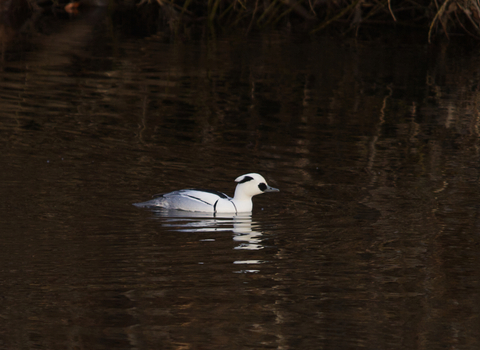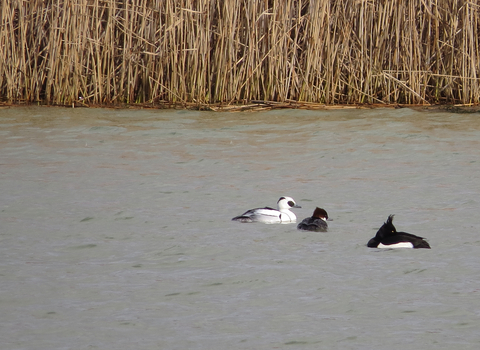
Smew (male) © Tom Hibbert
Smew © Tom Hibbert

Smew pair (with tufted duck) © Lauren Booth
Smew
This small duck is an uncommon winter visitor to the UK, where they're usually found on lakes, reservoirs and gravel pits.
Enw gwyddonol
Mergellus albellusPryd i'w gweld
November to MarchSpecies information
Ystadegau
Length: 41cmWingspan: 62cm
Classified in the UK as Red under the Birds of Conservation Concern 5: the Red List for Birds (2021). Protected in the UK under the Wildlife and Countryside Act, 1981.
Habitats
Ynghylch
The smew is a small sawbill, a group of ducks named for their serrated bills. They're diving ducks, which spend a lot of time under the water hunting for food - mostly aquatic insects in summer and small fish in winter.Smews are winter visitors to the UK, with most birds not arriving until at least December and leaving again by the middle of March. They spend the summer in the taiga forests of northern Scandinavia and Russia, where they nest around lakes, ponds, rivers and other water-logged places with lots of trees. The females lay their eggs in holes high up tree trunks, lining their nest with soft down feathers. They often use old cavities excavated by black woodpeckers, though they'll happily use large nest boxes instead. The ducklings will jump down to the ground at just a day or two old and make their way to the nearest water.
Outside of the breeding season, smews can sometimes form large flocks but are usually found in small groups. In the UK, most sightings of smews involve single birds, or very small groups. The best place to look for a smew is on a lake, reservoir or gravel pit; often places that hold wintering goldeneyes can also attract a smew. Some sites reliably host a smew or two, or even a small flock, every year. Most of the smews that make it to the UK are females or young bird, as the adult males tend to stay closer to their breeding grounds.
The number of smews reaching the UK each winter has decreased dramatically in recent decades and they are now considered a scarce visitor. In the mid 20th century, hundreds would spend the winter here, with a record 144 counted at a single London reservoir in 1956. By contrast, in 2019 it was estimated that only 130 smews wintered in the whole of Britain. This decrease has been attributed to the effects of climate change, with warmer winters meaning the birds don't need to travel as far from their breeding grounds to escape freezing conditions. However, smews are very prone to move around in winter in response to the weather conditions, so spells of very cold weather on the continent can push more across the North Sea to the UK.
Sut i'w hadnabod
A dainty duck, only a little larger than a teal. Smews spend a lot of time actively feeding, diving energetically beneath the water and remaining submerged for some time.Adult males are unmistakeable, with a striking black and white plumage. They're mostly white but with a black back, grey flanks, and narrow black lines on the sides of the breast and rear of the head. They also have a black patch around each eye that reaches the base of the short, dark bill. They have longer feathers on their crown that form a drooping crest.
Adult females and young birds are much greyer, with a chestnut head and a white throat that reaches around onto the cheeks. By mid-winter, young males usually start to show a few white feathers on their head.
